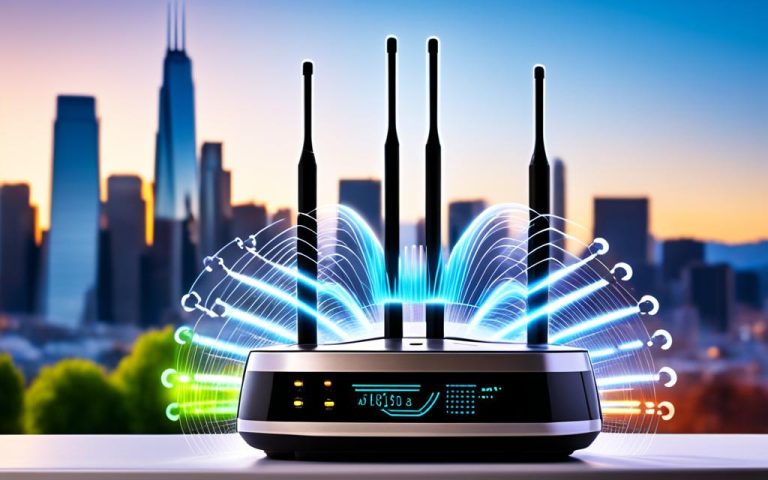Wireless network security is of paramount importance in today’s digital landscape. With the increasing prevalence of wireless networks and the constant threat of unauthorized access, it is crucial to implement robust WLAN security protocols to safeguard your local area wireless networks.
Wireless networks are vulnerable to eavesdropping, data theft, and disruption without proper security measures in place. This can compromise confidential information and disrupt crucial business operations. Therefore, understanding and implementing effective WLAN security protocols is essential for protecting your wireless networks and ensuring the safety of your sensitive data.
WLAN security protocols encompass a range of measures such as encryption, authentication, access control, and intrusion detection and prevention. By implementing these protocols, you can establish a secure and trustworthy network environment that instills confidence in your customers, clients, and partners.
In this article, we will explore different WLAN security protocols, their functionalities, and the best practices for safeguarding your local area wireless networks. Whether you are a small business owner, an IT professional, or a concerned individual, this information will empower you to make informed decisions and protect your wireless networks from potential threats. Stay tuned!
What is Wireless Security?
Wireless security encompasses technology and practices aimed at protecting wireless networks from unauthorized access, data theft, and other malicious activities. With wireless networks utilizing radio waves to transmit data, they are vulnerable to eavesdropping and unauthorized access. To ensure the confidentiality and integrity of these networks, various security measures are implemented. These measures include encryption protocols, access control rules, and authentication procedures.
Wireless security protocols, such as WEP, WPA, WPA2, and WPA3, are commonly employed to secure wireless networks. The choice of the security protocol depends on factors such as vulnerability to attacks and encryption strength.
“Wireless security is vital for protecting wireless networks from unauthorized access and data theft.”
Wireless Security Measures
Wireless security measures are designed to protect wireless networks from unauthorized access and safeguard network confidentiality and integrity. These measures include:
- Encryption Protocols: Utilizing encryption algorithms, data transmitted over wireless networks is converted into a code that can only be understood by authorized users.
- Access Control Rules: Determine which users or devices are allowed to connect to the network and the level of access they have.
- Authentication Procedures: Verify the identities of users and devices attempting to connect to the network.
By implementing these security measures, wireless networks can be protected against unauthorized access, data theft, and other potential security breaches.
How Does Wireless Security Work?
Wireless security measures are essential for safeguarding wireless networks from unauthorized access and ensuring the confidentiality and integrity of data. This section explores the key components of wireless security, including encryption, authentication, access control, and intrusion detection and prevention.
Encryption: Protecting Data Transmission
Encryption is a fundamental aspect of wireless security. It involves converting data into a code that can only be understood by authorized users with the correct key. By encrypting data, wireless networks mitigate the risks associated with eavesdropping and unauthorized access. Strong encryption protocols, such as Advanced Encryption Standard (AES), enhance the security of wireless networks and protect sensitive information from interception.
Authentication: Verifying User and Device Identities
Authentication processes play a crucial role in wireless security. They verify the identities of users and devices attempting to connect to the network. By implementing strong authentication mechanisms, such as password-based authentication or digital certificates, wireless networks can ensure that only authorized individuals and devices gain access. This prevents unauthorized users or devices from infiltrating the network and potentially compromising its security.
Access Control: Managing Network Connections
Access control rules are implemented to determine which users or devices are allowed to connect to the wireless network and the level of access they have. By defining access policies and permissions, organizations can enforce security measures and restrict access to sensitive resources. This helps prevent unauthorized users from gaining access to confidential information or disrupting network operations.
Intrusion Detection and Prevention: Monitoring Network Security
Wireless networks are vulnerable to various attacks. To identify and respond to potential security breaches, intrusion detection and prevention systems are deployed. These systems continuously monitor network traffic, detect suspicious activities, and take proactive measures to prevent unauthorized access. Intrusion detection and prevention systems provide an additional layer of protection, ensuring the ongoing security and availability of wireless networks.
In summary, wireless security measures involve encryption, authentication, access control, and intrusion detection and prevention. By implementing robust security protocols and practices, organizations can mitigate the risks associated with wireless networks and protect their data from unauthorized access or compromise.
Types of Wireless Security Protocols and How They Work
Wireless security protocols play a critical role in safeguarding wireless networks by encrypting data and providing authentication mechanisms. These protocols use different encryption algorithms and access control rules to determine network access. Let’s explore some of the most commonly used wireless security protocols:
1. Wired Equivalent Privacy (WEP)
WEP, the oldest wireless security protocol, is no longer considered secure due to its vulnerability to attacks. It uses a shared key authentication method and RC4 encryption algorithm. However, WEP’s weak encryption and flawed key management make it susceptible to unauthorized access.
2. Wi-Fi Protected Access (WPA)
WPA is a more secure wireless security protocol that addresses WEP’s limitations. It uses the Temporal Key Integrity Protocol (TKIP) encryption algorithm and provides stronger data encryption and key management. WPA also introduces dynamic session keys to enhance security.
3. Wi-Fi Protected Access 2 (WPA2)
WPA2 is currently the most widely used wireless security protocol. It significantly improves upon WPA’s security by adopting the Advanced Encryption Standard (AES) encryption algorithm. AES is a robust encryption algorithm that provides enhanced data confidentiality and integrity. WPA2 also enhances key management through the use of the 4-way handshake process.
4. Wi-Fi Protected Access 3 (WPA3)
WPA3 is the latest wireless security protocol, offering advanced security features. It introduces Simultaneous Authentication of Equals (SAE), a more secure authentication method that protects against offline dictionary attacks. WPA3 also improves encryption by implementing the 192-bit security suite, providing stronger protection for wireless networks.
How Wireless Security Protocols Work
Wireless security protocols work by encrypting data and authenticating devices and users. When a device attempts to connect to a wireless network, it goes through an authentication process where it proves its identity to the network. Once authenticated, the device and the network establish a secure connection using encryption algorithms to protect the data transmitted between them. Access control rules dictate which devices are allowed to connect to the network and what level of access they are granted.
Implementing the appropriate wireless security protocol is crucial for ensuring the confidentiality, integrity, and availability of wireless networks. Organizations and individuals should carefully consider their security requirements and choose the most suitable protocol to protect their wireless networks.

| Wireless Security Protocol | Encryption Algorithm | Key Management | Security Level |
|---|---|---|---|
| WEP | RC4 | Shared Key Authentication | Low |
| WPA | TKIP | Dynamic Session Keys | Medium |
| WPA2 | AES | 4-way Handshake | High |
| WPA3 | SAE | 192-bit Security Suite | Very High |
*Note: The security levels mentioned may vary depending on specific configurations and implementations.
How to Protect Your Wi-Fi Network
Protecting your Wi-Fi network from unauthorized access is crucial for ensuring the security and privacy of your data. By following these steps, you can establish a strong defense against potential threats.
Choose a Strong Password
Start by selecting a strong and unique password for your Wi-Fi network. A strong password should be a combination of upper and lowercase letters, numbers, and symbols. Avoid using common phrases or personal information that can be easily guessed. Remember to update your password regularly to maintain security.
Update your Router Firmware
Regularly updating your router firmware is essential for keeping your network secure. Manufacturers release firmware updates to fix vulnerabilities and enhance security features. Check your router’s documentation or the manufacturer’s website for instructions on how to update the firmware.
Enable Network Encryption
Encrypting your network is an effective way to protect your data from being intercepted by unauthorized users. Choose either WPA2 or the latest WPA3 encryption standard for enhanced security. Encryption ensures that data transmitted over your Wi-Fi network remains confidential and cannot be easily decoded.
Disable Remote Management
To prevent unauthorized changes to your router settings, disable remote management. Remote management allows access to your router’s configuration settings from outside your network. By disabling this feature, you minimize the risk of unauthorized access to your network.
Use a Firewall
Installing a firewall on your router and connected devices adds an extra layer of protection against unauthorized access and malicious activities. A firewall filters incoming and outgoing network traffic, blocking suspicious connections and potential threats.
Back up Your Data
Regularly backing up your important data safeguards against data loss and potential ransomware attacks. Store your backups on offline or cloud storage solutions to ensure they remain protected. In the event of a security breach or system failure, you can restore your data and continue operations securely.
Implementing these Wi-Fi network protection measures will significantly enhance the security of your network and safeguard your sensitive information from unauthorized access.
Remember, protecting your Wi-Fi network is an ongoing process. Stay vigilant and keep up with the latest security practices and updates to maintain a secure and reliable network environment.
Wireless Network Security
Wireless network security plays a vital role in safeguarding sensitive information, protecting against unauthorized access, and ensuring the integrity and availability of network resources. A secure wireless network prevents attackers from intercepting data, gaining unauthorized access, and using the network for malicious purposes.
One of the key components of wireless network security is strong authentication. By implementing secure authentication procedures, organizations and individuals can verify the identities of users and devices attempting to connect to the network. This ensures that only authorized individuals or devices gain access, minimizing the risk of unauthorized access and data breaches.
Data protection is another essential aspect of wireless network security. Encryption protocols are used to convert data into a code that can only be understood by authorized users with the correct key. This ensures that even if the data is intercepted, it remains unreadable and protected from prying eyes.
Access control policies are crucial for securing wireless networks. By implementing access control rules, organizations can determine which users or devices are allowed to connect to the network and the level of access they have. This helps prevent unauthorized users from accessing sensitive information or network resources.
Implementing wireless network security measures, such as strong authentication, encryption, and access control, is essential for protecting against unauthorized access and data breaches. Regular updates, vulnerability assessments, and intrusion detection systems further enhance network security and help identify and mitigate potential threats.
To visually represent the importance of wireless network security, consider the following table:
| Benefits of Wireless Network Security | Importance |
|---|---|
| Protection against unauthorized access | Prevents unauthorized individuals or devices from gaining access to the network |
| Data protection | Encrypts data to ensure confidentiality and integrity |
| Secure authentication | Verifies the identities of users and devices, minimizing the risk of unauthorized access |
To further enhance wireless network security, organizations and individuals should stay updated with the latest security measures, follow best practices, and prioritize network security as an ongoing effort.
WLAN Standards and Home Network Security
When it comes to home network security, WLAN standards play a crucial role. In order to ensure the safety of your wireless network, it is important to understand the different protocols and encryption methods used for securing your home network. Let’s take a closer look at these standards:
Wired Equivalent Privacy (WEP)
WEP was one of the first encryption protocols used to secure wireless networks. However, due to its vulnerabilities to attacks, it is no longer considered secure and should be replaced with more advanced protocols.
Wi-Fi Protected Access (WPA) and WPA2
WPA and WPA2 are widely used standards for securing home wireless networks. They both utilize the Advanced Encryption Standard (AES) algorithm, providing stronger encryption and improved security compared to WEP. These protocols offer enhanced protection against unauthorized access and data theft.
WPA3
The latest protocol, WPA3, incorporates even stronger encryption, enhanced key exchange, and improved authentication mechanisms. By upgrading to WPA3, home network owners can benefit from heightened security measures and better protection against emerging threats.
Combining the latest WLAN standards with strong encryption and authentication methods is essential for ensuring the security of your home wireless network. By doing so, you can safeguard your data and protect against unauthorized access.
| WLAN Protocol | Encryption | Authentication |
|---|---|---|
| WEP | Weak | Basic |
| WPA and WPA2 | AES | Strong |
| WPA3 | Stronger | Enhanced |
Having a secure home network not only protects your data and privacy but also provides peace of mind. By staying up-to-date with the latest WLAN standards and implementing robust security measures, you can create a safe and reliable environment for your wireless devices.
Conclusion
Wireless network security is vital for protecting wireless networks, securing data, and preventing unauthorized access. By implementing strong authentication procedures, encryption protocols, and access control rules, organizations and individuals can enhance the security of their wireless networks.
Regular updates and vulnerability assessments are crucial for keeping networks protected against emerging threats. It is important to prioritize the adoption of the latest wireless security protocols, such as WPA3, which provide stronger encryption, improved authentication, and enhanced protection against attacks.
By following best practices and putting wireless network security at the forefront, individuals and organizations can safeguard their data and maintain the integrity of their networks. Protecting wireless networks is not just about protecting the privacy and security of data, but also maintaining the trust of customers and partners.
Securing wireless networks is an ongoing process that requires constant vigilance, awareness of emerging threats, and proactive measures. By staying informed and taking proactive steps, organizations and individuals can protect their data, network resources, and maintain the overall security of their wireless networks.
FAQ
What are WLAN security protocols?
WLAN security protocols are measures implemented to protect wireless networks from unauthorized access and ensure the safety of sensitive data. These protocols involve encryption, authentication, access control, and intrusion detection and prevention.
Why is wireless security important?
Wireless security is important because wireless networks are vulnerable to eavesdropping, data theft, and disruption without proper security measures in place. Implementing strong authentication procedures, encryption protocols, and access control rules is crucial for securing wireless networks and maintaining the trust of customers and partners.
How does wireless security work?
Wireless security works by implementing various measures to prevent unauthorized access and protect the network’s security and availability. Encryption protocols are used to convert data into a code that can only be understood by authorized users with the correct key. Authentication processes verify the identities of users and devices attempting to connect to the network. Access control rules determine which users or devices are allowed to connect to the network and the level of access they have. Intrusion detection and prevention systems monitor the network for suspicious activities and security breaches.
What are the types of wireless security protocols?
Wireless security protocols include WEP, WPA, WPA2, and WPA3. WEP, the oldest protocol, is no longer considered secure. WPA and WPA2 offer stronger encryption and improved management, with WPA2 being the most widely used protocol. WPA3 is the latest protocol and provides enhanced security features such as stronger encryption and protection against dictionary attacks.
How can I protect my Wi-Fi network?
To protect your Wi-Fi network from unauthorized access, you can take several steps. Choose a strong and unique password for your network, regularly update your router firmware, enable network encryption using WPA2 or WPA3, disable remote management, and use a firewall on your router and connected devices. Backing up important data also helps protect against ransomware attacks.
Why is wireless network security important?
Wireless network security is crucial for protecting sensitive information, preventing unauthorized access, and ensuring the integrity and availability of network resources. A secure wireless network prevents attackers from intercepting data, gaining unauthorized access, and using the network for malicious purposes. Strong authentication, encryption, and access control policies are essential for securing wireless networks.
What are WLAN standards and their role in home network security?
WLAN standards such as WEP, WPA, WPA2, and WPA3 play a significant role in home network security. Older protocols like WEP are no longer secure and should be replaced. WPA and WPA2, using the Advanced Encryption Standard (AES), are widely used for home network security. WPA3, the latest protocol, provides stronger encryption, enhanced key exchange, and improved authentication mechanisms.
What is the importance of wireless network security?
Wireless network security is essential for safeguarding wireless networks, protecting data, and preventing unauthorized access. By implementing strong authentication procedures, encryption protocols, and access control rules, organizations and individuals can enhance the security of their wireless networks. Regular updates, vulnerability assessments, and intrusion detection systems further enhance network security.



















